|
|
jorshw

New Member

Posts:36
 |
| 07 Nov 2011 09:02 PM |
|
Yup, on the roof deck between the rafters. The rafters are real 2x8's so there is plenty of room to add cheaper batts or blown in cellulose as the budget permits. |
|
|
|
|
Dana1

Senior Member

Posts:6991
 |
| 08 Nov 2011 12:17 PM |
|
Full dimension 2x8s will have a higher framing fraction cutting into performance so assuming a 13-15% framing fraction you might be as low as R11-12 for a whole-assembly R with foam-alone.
But the principle is the same- filling the rest of the 8" deep bay with 5" of the cheap stuff will improve performance to about R25-26(!), cutting the heat transfer literally in half at relatively low cost. |
|
|
|
|
jorshw

New Member

Posts:36
 |
| 01 Dec 2011 01:04 PM |
|
Foam in the attic is done...
https://lh6.googleusercontent.com/-t_FW9OxV7zk/TtP84eYjc8I/AAAAAAAAAsQ/6g8ykIkPfJ8/s912/IMG_0349.JPG
https://lh4.googleusercontent.com/-XDc7_-Xachw/TtP80pjYrZI/AAAAAAAAAsI/28lTlh9Prqs/s912/IMG_0348.JPG
Also replaced a rotten door...
https://lh4.googleusercontent.com/-XoKhRSSSdVM/TtP9VZVhKgI/AAAAAAAAAsw/sXLnzR_kNxE/s912/IMG_0353.JPG
https://lh4.googleusercontent.com/-eRr3vgfd18c/TtP9ZbMBIII/AAAAAAAAAuY/0JtAMg6Rm2M/s720/IMG_0354.JPG
Next up:
Tankless water heater to replace 17 year old tank unit
Replace rotten window
Excavate and insulate slab perimeter (also some regrading at the same time to fix a drainage issue)
Build pergola on south-east end
Replace water damaged siding surrounding entryway with Hardi-plank over XPS
etc
etc
|
|
|
|
|
Dana1

Senior Member

Posts:6991
 |
| 01 Dec 2011 06:06 PM |
|
Houses are never really done, eh? ;-) (My own punch list grows ever longer...) |
|
|
|
|
Dana1

Senior Member

Posts:6991
 |
| 01 Dec 2011 09:58 PM |
|
BTW: Before pulling the trigger on a gas or propane fired tankless unit, read this.
It's a lot of long paper- you may not have time to do it all, but the gist of it starts on p61, which is, yes a tankless is more efficient than a tank, but not by anywhere near as much as the EF test results would indicate (and not enough for it to pay off EVER at current natural gas prices.) In this in-situ testing all water heaters failed to hit their EF numbers, but the plain-old tanks failed by more than the tankless units. The reason the tanks underperformed is largely because the daily volume draws were lower (in some cases dramatically lower) than the EF test volumes- the standby loss is the same, but for lower water output. With tankless units they underperform because a fixed amount of heat is thrown away with every flue-purge, and the number of draws is far greater, and the average length of draws is far shorter than in an EF test. From a money/payback point of view, at $1.20/therm it would take between 20-40 years to recoup the installed cost difference on fuel savings, even at a simple payback. (With net-present value, fuggedaboudit.) The primary reasons to go tankless are you never run out of hot water, and it takes less space. For the same or less money you can achieve greater fuel savings using drainwater heat recovery heat exchangers if you're a showering family, or by spending the cost-delta on air-sealing the place to under 2ACH/50 and buying a heat recovery ventilator, or buying better windows & insulation, saving space heating energy rather than HW heating energy. One of the authors (Thomas Butcher) works at Brookhaven National Labs, and has published decent data on hydronic boiler efficiency (at different levels of oversizing for the space heating load), and heating hot water with indirect-fired tanks vs. embedded HW coils vs. standalone gas hw heaters. |
|
|
|
|
jorshw

New Member

Posts:36
 |
| 02 Dec 2011 09:09 AM |
|
The big reasons for considering tankless are 1) Space savings in our utility room which I would like to put a workbench in and 2) reducing the length of the runs to the far end of the house by placing the unit in the attic. 3) The water heater we have at 17 years old is living on borrowed time.
The house is roughly 2500sq-ft but all one story with the water heater near one end of the house, one shower about 50ft away and one about 75ft away, with the kitchen relatively close. Moving the unit to the attic could get the same length run to the kitchen as we have at present while shortening the runs to the showers by 25ft each.
We can also get the following rebates/credits
1) Installations are eligible for a $100 Rebate from Rinnai (offer expires 12/31/2011),
2) a $250 Rebate from Washington Gas,
3) an additional $200 Rebate from Rinnai/Washington Gas (while funding lasts; offer expires 12/31/2011),
4) and a $300 Federal Tax Credit (expires 12/31/2011)
And the local installer has the Rennai RC80i condensing unit for about $1400
What do you think? |
|
|
|
|
jonr

Senior Member

Posts:5341
 |
| 02 Dec 2011 09:58 AM |
|
"it would take between 20-40 years to recoup the installed cost difference on fuel savings"
Maybe, or maybe zero years. It completely depends on how much each option costs. For my situation, installed costs are about the same. |
|
|
|
|
jorshw

New Member

Posts:36
 |
| 02 Dec 2011 10:01 AM |
|
Does that analysis include the expectation that you would likely have to replace the tanked heater more often (perhaps twice in 40 years vs maybe once for the tankless) or is it just based on energy costs? |
|
|
|
|
NRT.Rob

Veteran Member

Posts:1741
 |
| 02 Dec 2011 10:04 AM |
|
what? tankless heaters require far more maintenance than tank heaters. You ever seen the passages on those heat exchangers?
Maintenance costs alone would wash out most of the DHW savings for most tankless units.
If you think a tankless heater is going to last 20 years in a typical application... well, I'd think you're being a bit generous. |
|
| Rockport Mechanical<br>RockportMechanical.com |
|
|
acwizard

Basic Member

Posts:265
 |
| 02 Dec 2011 12:34 PM |
|
I agree with NRT.Rob. As a service company , we see tankless water heater so badly scaled up that the only cure is replacement. The inlet water strainer plugs up constantly and needs to be disassembled and cleaned. Not to mention one had better descale at least once a year with an approved chemical. Lots of money for maintenance and just where is the savings. I prefer the high efficiency water heaters like the Vertex or Polaris and you will not have a problem such as not enough flow to activate tankless to ignite. |
|
|
|
|
Dana1

Senior Member

Posts:6991
 |
| 02 Dec 2011 05:04 PM |
|
The scaling & liming issue is entirely a function of the water supply hardness. Old-school tankless units (the keep-it-simple stupid ~75-80% efficiency variety long popular in Europe) in non-hardwater areas can last for decades, whereas in hardwater country annual deliming may be necessary. (If that's the case, plumb in some ball valves and ports to be able to do this without cutting into the plumbing.) I lived with one of those for !15 years without trouble before the thermocouple to the standing pilot started getting flaky (cleaned up every 3 months it continued to work) but it was retired fully-functional without a hint of liming issues on the heat exchanger when I hacked together a new heating system, and probably could have gone a decades longer. If I'd wanted to spend the $50 for the replacement thermocouple it would have continued to deliver pretty much the same service as on day-1, but I was already deep into the plans for the new system by the time it was mis-behaving.
But the complexity of the controls, and sensors used on the new-school bigger deal tankless units doesn't give me confidence that they'll go 20+ years without some sort of repair or maintenance. The warranties don't exactly back up the thesis that they'll go that long, and even if the heat exchangers might, there's just a whole lot more to them. Blowers fail, flow sensors & flame sensors get flaky, most will need something more than just cleaning the filters annually by the time they're a decade old. Lighting strikes and power surges can take them down too.
If you can the Rinnai RC80i installed in your attic for under $2000 after rebates I'd be surprised. $1400 is close to the internet price for the base unit, but doesn't cover the custom venting, etc. Plumbing the 1-1/4" or fatter gas lines up to the attic won't be free- you can't just run 3/4" gas lines willy-nilly to a 157K burner just because the connection is 3/4" and expect it to actually work (and the installer should know that, and test the pressure drops with manometers under different firing conditions, etc.)
Read the financial analysis portion of the document- they DO acknowledge that if the thing makes it 20+ years maintenance-free the replacement cost of the tank in that period may tip the balance in some cases.
If you've got a big tub or spa to fill that would call for a ridiculously sized tank (or tanks) a tankless is a good way to go. But if the floor rating in the attic can handle a tank (probably can) that might preferable. The standard Vertex has only half the burner of the RC80i, similar up-front money, and probably comes with similar incentives, and is designed to be tapped for combi use for low-temp hydronic applications, if you go ahead with radiant floor/ceiling so or panel radiators. With 76K condensing burner it should be able to handle the space heating load on top of the DHW load without much trouble once you've finished tightening the place up, and being inherently-massive you can microzone the place to the point of ridiculousness without cutting into efficiency or longevity. |
|
|
|
|
jonr

Senior Member

Posts:5341
 |
| 02 Dec 2011 05:43 PM |
|
Blowers fail, flow sensors & flame sensors get flaky, most will need something more than just cleaning the filters annually by the time they're a decade old. Lighting strikes and power surges can take them down too. All of which except filters apply to my current direct vent tank heater. On the other hand, with softened water, corrosion of a steel tank is a real issue and hardness buildup isn't. Replacing anode rods and cleaning up the wet floor when the tank goes is a pain. Then there are those nasty smelling bacteria that love to grow in a steel tank. Maybe some legionella too. |
|
|
|
|
jorshw

New Member

Posts:36
 |
| 20 Jan 2012 12:10 PM |
|
Unrelated question....
This morning I went to take a shower and got sharp water-hammering whenever i opened the valve enough to produce more than the laziest of showers. In fact,t he hammering would turn into a severe shutter with choppy water delivery until I reduced the flow. We have never had any water hammering in this house since we moved in 4 months and hundreds of showers ago. I tried other faucets and the other shower and got no hammering.
The valves are all original 1950s compression valves and I was wondering if it might be possible that something has come loose in the valve causing this like the rubber compression washer or what.... Perhaps we just had really high water pressure in the house this morning? |
|
|
|
|
jorshw

New Member

Posts:36
 |
| 20 Jan 2012 03:25 PM |
|
Radiant-Related question:
So, after talking to some of the old-timers in the neighborhood, it turns out that the abandoned radiant floor heat system was serviceable until sometime in 2005 if not more recently than that. This also coincides with the installation of the forced-air natural gas furnace in the attic around the same time period. The original builder/owner/architect of the home lived in the house from 1953 till 2003 and it was kept operable the whole time.
This makes me think that the system is likely serviceable and likely NOT steel pipes embedded in concrete but some other design that has a longer service life and is easier to work on (copper pipes, pipes in sand or gravel below the slab, etc).
I will try to get some photos taken this evening an post them up to see what people think. We might just need someone who is an expert in these older radiant floor systems to come out and give it a look over and identify/repair any leaks... |
|
|
|
|
jorshw

New Member

Posts:36
 |
| 21 Jan 2012 06:00 PM |
|
OK, pics of the system as promised: My camera does not have a wide angle lens and the room is small so this is the best I could do. This shows most of the system and the huge old furnace. Pipes are color coded Red=hot blue-green=cold yellow-green=Gas supply. Beyond that, I know very little other than that I can identify pumps and cutoff valves pretty easily. You can see here that the gas supply line has been disconnected and a smaller gas line has been run back up into the attic to feed the forced-air furnace installed in 2005/2006  Hot water distribution 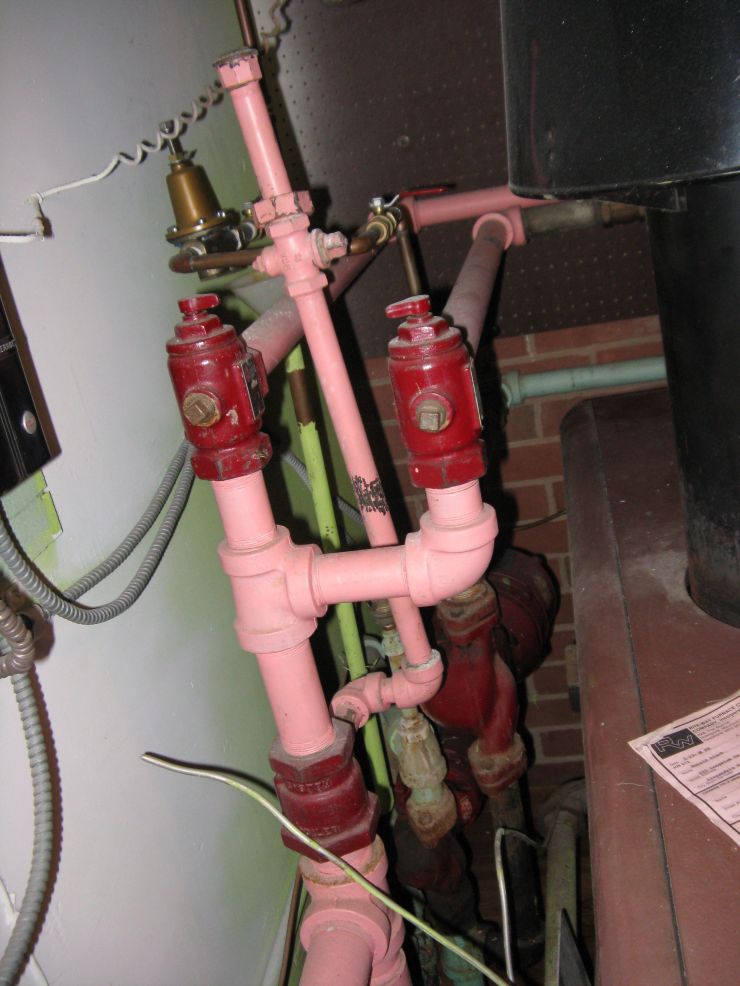 You can see it has two zones (sleeping & living) The bare copper pipe connects to the cold-water feed at the domestic hot water heater--presumably for filling the system.  Rounding the bend a bit, you catch a glimpse of the cold return from the sleeping zone  Here the pipes enter/exit the slab--really nothing to see The green-yellow pipe is the gas line for the domestic hot water heater. 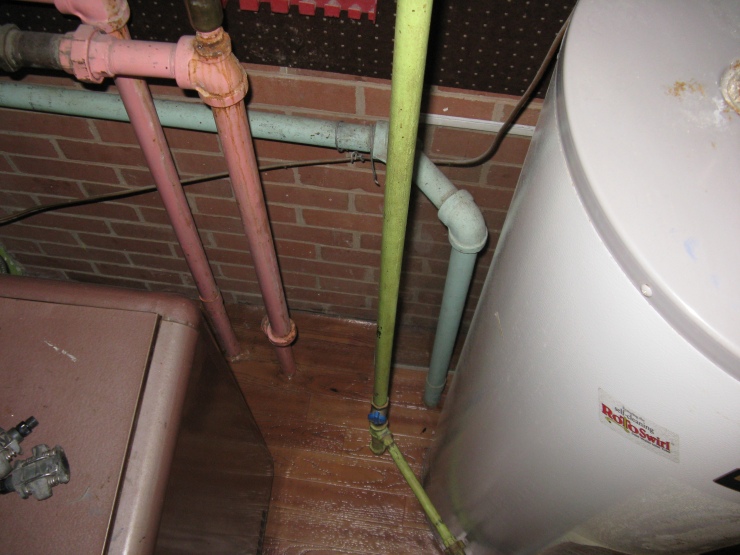 Looking down on one of the two pumps--this is the larger of the two and is connected to the cold return from the sleeping zone (which is the zone furthest away)  This is the cold return manifold from the living zone. It is right next to the furnace. You can see the second smaller pump for this zone in the background here. There is a second manifold like this in a closet in the sleeping zone also painted blue-green. There is no evidence of an above-slab hot-side distribution manifold for either zone.  Another picture of the pump from the same side. The pipe on the right side of the frame running front to back is painted green-yellow for gas and comes out of the furnace, runs along the side and back into the furnace. I assume the furnace has two boilers one for each zone. 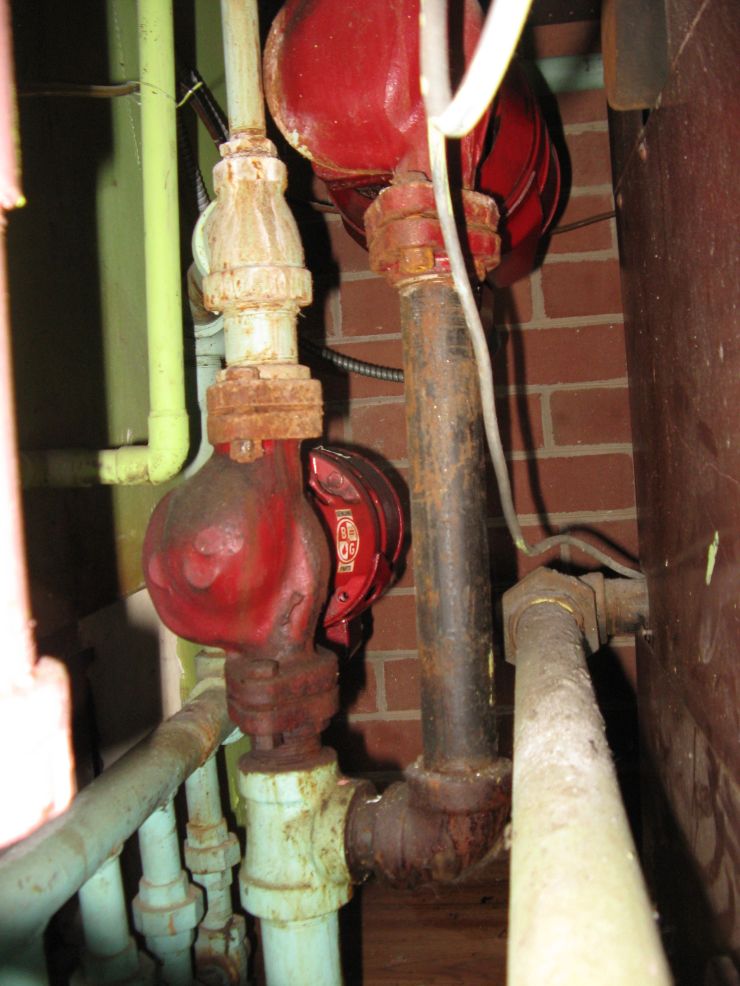 Better view of the gas pipe described in the photo above.  Backside of the smaller pump (living zone) 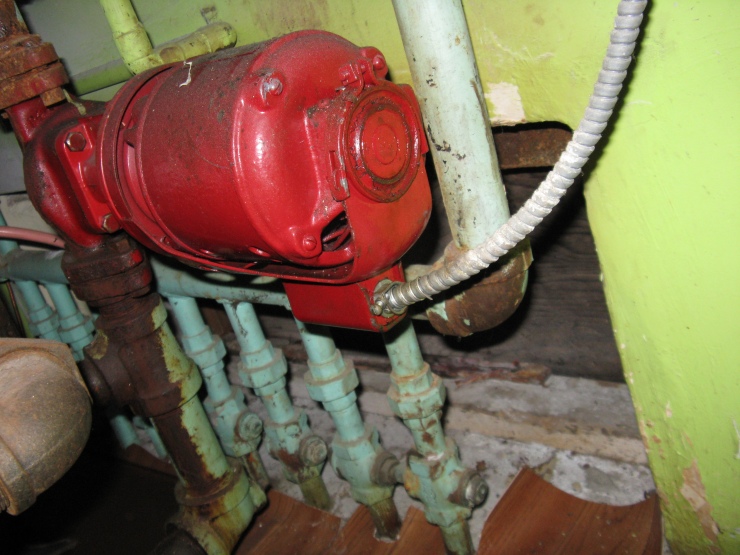 Control panel.... 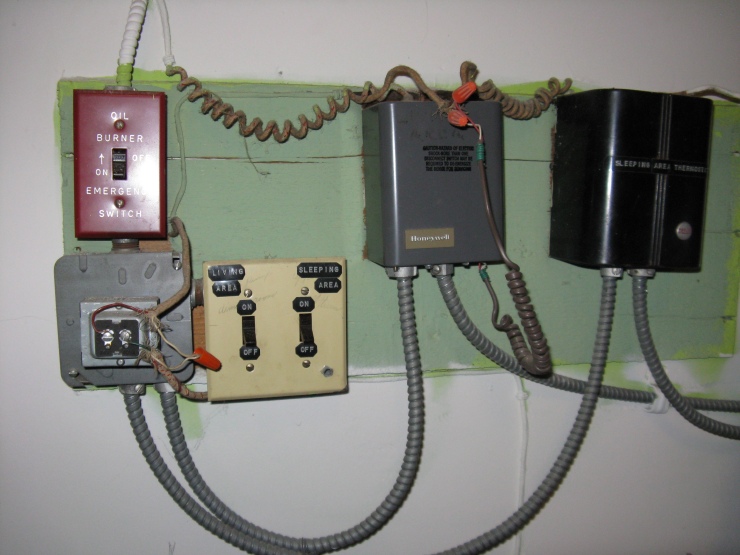 There are two thermostats in the house for this system sleeping & living This is the Living zone thermostat. I am not sure if the large 3-way switch below is for the radiant system or for a whole-house fan that no longer exists...  Slleeping zone  |
|
|
|
|
BadgerBoilerMN

Veteran Member

Posts:2010
 |
| 21 Jan 2012 06:53 PM |
|
Steel pipe or copper in an old radiant slab is of no concern. Start with a proper heat load analysis (after envelope improvements) and have a current radiant floor contractor (intrepid would be good) put an air pressure test on the old system.
We have rehabs dozens of these old radiant floor slab systems (and many old radiant ceiling systems as well) here in Minneapolis with perfect success. Even if one of the loops leaks it does not mean the hole system has failed or will fail for that matter. We recommend a properly sized and controlled condensing boiler be installed or at least a conventional boiler with weather sensitive controls (outdoor reset) which, will likely extend the life of any old radiant floor or ceiling, use less energy and be more comfortable than anything you can buy today.
Pink pipes, now that's a first for this old boiler guy. |
|
| MA<br>www.badgerboilerservice.com |
|
|
Dana1

Senior Member

Posts:6991
 |
| 23 Jan 2012 11:36 AM |
|
'tis a thing of beauty, and probably cost big bux back in the day!
And with no insulation on the plumbing I'll bet it's pretty toasty in there when the system is running. If you revive it, some pipe insulation is in order, even with a low-temp mod-con boiler at the heart of it.
Is it the picture or the thermostat that's inverted in the pic with the 3-way switch? (Would an old mercury-switch Honewell even work correctly if mounted upside down?) |
|
|
|
|
jorshw

New Member

Posts:36
 |
| 23 Jan 2012 11:47 AM |
|
Posted By Dana1 on 23 Jan 2012 11:36 AM
'tis a thing of beauty, and probably cost big bux back in the day!
I am sure it did. The builder/owner was also a big time architect and the place was certainly ahead of its time with the construction, the siting, the large closets, a master bath in 1953 was pretty unheard of....
And with no insulation on the plumbing I'll bet it's pretty toasty in there when the system is running. If you revive it, some pipe insulation is in order, even with a low-temp mod-con boiler at the heart of it.
Yeah, even just the domestic hot water heater keeps the utility room fairly warm and it has insulation on the pipes.
Thing is, when this place was built the ONLY places they appear to have put any insulation were as follows:
1) Asbestos pipe insulation on the long runs in the attic floor that supply the showers that are 55 and 75 foot runs respectively.
2) Scraps of fiberglass insulation stuffed behind outlets and wall switch outlets on the exterior walls.
3) A dusting of rockwool in the attic floor.
Is it the picture or the thermostat that's inverted in the pic with the 3-way switch? (Would an old mercury-switch Honewell even work correctly if mounted upside down?)
Yes, both thermostat pictures need to be rotated 90 degrees. |
|
|
|
|
jorshw

New Member

Posts:36
 |
| 23 Jan 2012 12:06 PM |
|
Posted By BadgerBoilerMN on 21 Jan 2012 06:53 PM
Steel pipe or copper in an old radiant slab is of no concern. Start with a proper heat load analysis (after envelope improvements) and have a current radiant floor contractor (intrepid would be good) put an air pressure test on the old system.
Any recommended contractors in the Northern Virginia area? Or a way to find a good one? |
|
|
|
|
BadgerBoilerMN

Veteran Member

Posts:2010
 |
| 23 Jan 2012 09:50 PM |
|
http://badgerboilerservice.com/contractor.html
http://badgerboilerservice.com/helpme.html |
|
| MA<br>www.badgerboilerservice.com |
|
|